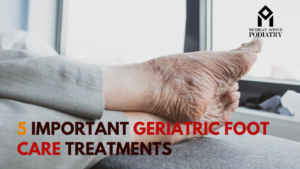As we age, our bodies undergo numerous changes, and our feet are no exception. Foot problems become increasingly common in the elderly population, affecting mobility, independence, and overall quality of life. That’s where geriatric podiatrists come in. These specialized foot care professionals are equipped with the knowledge and expertise to address the unique needs and challenges of aging feet. In this blog post, we’ll delve into the importance of geriatric foot care, common foot problems in the elderly, and the role of podiatrists in providing effective treatment and management.
Understanding Geriatric Foot Problems:
As individuals age, several factors contribute to an increased susceptibility to foot problems. These include:
- Reduced Skin Elasticity and Thinning: Aging leads to a decrease in skin elasticity and thinning of the skin, making it more prone to injuries, ulcers, and infections.
- Decreased Circulation: Poor circulation is a common issue among the elderly, impairing blood flow to the feet and increasing the risk of conditions such as peripheral artery disease (PAD) and diabetic neuropathy.
- Loss of Fat Padding: The natural fat padding on the soles of the feet diminishes with age, resulting in less cushioning and making the feet more susceptible to pressure sores and discomfort.
- Foot Deformities: Conditions like bunions, hammertoes, and arthritis become more prevalent with age, causing pain, stiffness, and difficulty with mobility.
- Chronic Health Conditions: Chronic conditions such as diabetes and arthritis can exacerbate foot problems and lead to complications if not properly managed.
The Role of a Geriatric Podiatrist:
Geriatric podiatrists are trained to address the specific needs of elderly patients and provide comprehensive foot care services. Here’s how they can help:
- Assessment and Diagnosis: A geriatric podiatrist conducts thorough examinations to assess the overall health of the feet, identify any existing problems or potential risks, and make an accurate diagnosis.
- Treatment Planning: Based on the diagnosis, the podiatrist develops personalized treatment plans tailored to the individual’s needs, which may include conservative measures, such as orthotics, padding, and footwear modifications, as well as medical interventions or surgical procedures when necessary.
- Preventive Care: Geriatric podiatrists emphasize preventive measures to reduce the risk of foot complications, such as regular foot inspections, proper hygiene and nail care, and education on foot health and self-management techniques.
- Management of Chronic Conditions: For elderly patients with chronic conditions like diabetes or arthritis, podiatrists work collaboratively with other healthcare professionals to manage these conditions effectively and minimize their impact on foot health.
- Footwear Guidance: Proper footwear is essential for maintaining foot health and preventing injuries. Geriatric podiatrists offer guidance on selecting supportive, well-fitting shoes that accommodate any foot deformities or conditions.
Common Geriatric Foot Problems and Treatment Options:
- Corns and Calluses: These thickened areas of skin commonly develop due to friction or pressure. Treatment may involve debridement, padding, and footwear modifications.
- Ingrown Toenails: Improper nail trimming or tight shoes can cause toenails to grow into the surrounding skin, leading to pain and infection. Treatment may include nail trimming, antibiotics, or surgical intervention.
- Plantar Fasciitis: Inflammation of the plantar fascia can cause heel pain, especially with the first steps in the morning. Treatment may involve stretching exercises, orthotics, and corticosteroid injections.
- Foot Ulcers: Chronic wounds or ulcers on the feet are particularly concerning for elderly individuals, especially those with diabetes. Treatment focuses on wound care, infection control, offloading pressure, and addressing underlying factors contributing to poor wound healing.
- Foot Deformities: Conditions like bunions, hammertoes, and flat feet can cause pain and impair mobility. Treatment options range from conservative measures such as orthotics and physical therapy to surgical correction for more severe cases.
Conclusion:
Geriatric foot care is a crucial aspect of overall health and well-being for the elderly population. By seeking the expertise of a geriatric podiatrist, older adults can receive specialized care tailored to their unique needs, helping to alleviate pain, prevent complications, and maintain mobility and independence for years to come. Whether it’s addressing common foot problems or managing chronic conditions, podiatrists play a vital role in promoting optimal foot health and enhancing the overall quality of life for elderly individuals.
Incorporating regular foot care into an elderly individual’s healthcare routine can go a long way in preserving their mobility, preventing falls, and improving their overall quality of life. With the guidance of a skilled geriatric podiatrist, seniors can continue to stay active, independent, and free from the discomfort of foot problems as they age.


